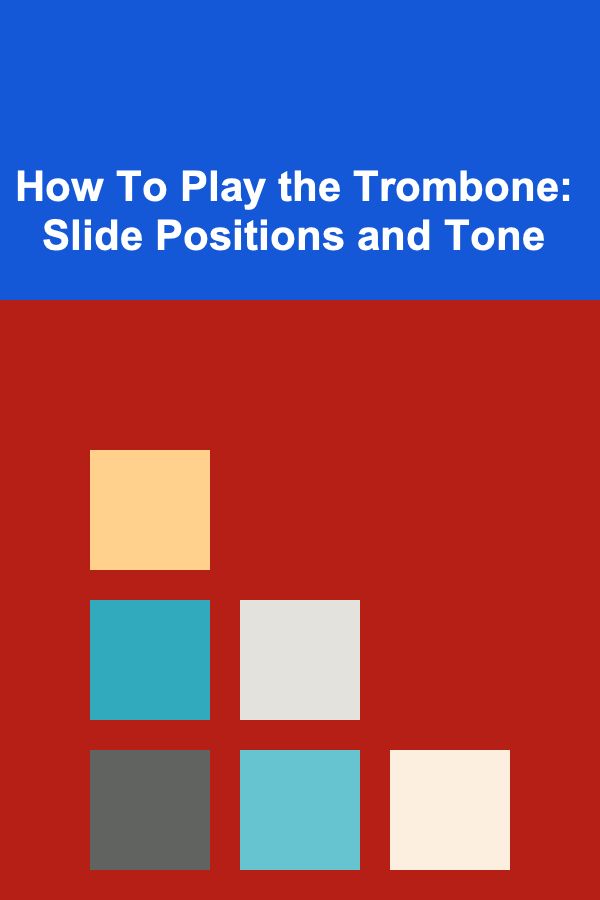
How To Play the Trombone: Slide Positions and Tone
ebook include PDF & Audio bundle (Micro Guide)
$12.99$5.99
Limited Time Offer! Order within the next:

The trombone, a unique and versatile brass instrument, has a distinctive sound that sets it apart from other instruments in the brass family. Known for its sliding mechanism, the trombone allows for smooth glissandos and precise pitch control, making it an essential tool in jazz, classical music, marching bands, and orchestras alike. Understanding how to play the trombone effectively involves mastering the slide positions and tone production. This article delves deeply into these two crucial aspects, providing a comprehensive guide for both beginners and advanced players.
The Trombone and Its Mechanics
The trombone is one of the only brass instruments that utilizes a sliding mechanism to change pitch. Unlike trumpets or tubas, which rely on valves, the trombone's pitch is altered by the player moving the slide in and out. This gives the trombone its characteristic smooth transitions between notes, and it also allows for a more expressive range of sounds. While learning how to play the trombone might seem daunting at first, with the right understanding of its mechanics and practice, anyone can master this beautiful instrument.
Components of the Trombone
Before we dive into slide positions and tone, it's essential to understand the basic components of the trombone:
- Mouthpiece: The trombone's mouthpiece is where the player creates their embouchure, producing sound through vibrations of the lips. It is essential to choose a mouthpiece that suits your playing style and comfort.
- Slide: The slide is the trombone's defining feature. It is made up of two tubes---one stationary and one movable. By pushing and pulling the slide, the trombonist changes the length of the instrument, thus altering the pitch.
- Bell: The bell of the trombone amplifies the sound created by the player. The larger the bell, the more resonant the tone can be.
- Slide Lock: This is a mechanism that prevents the slide from accidentally falling out of alignment or from being pulled too far out of place.
Understanding Slide Positions
Slide positions are crucial in playing the trombone. Since the trombone lacks valves that can alter the pitch of the instrument, the player must rely on slide positions to reach the correct notes.
What Are Slide Positions?
Slide positions refer to the specific locations along the slide that correspond to different pitches. There are seven main positions on the trombone, each of which corresponds to a specific pitch when the player is buzzing their lips into the mouthpiece.
The Seven Slide Positions
-
First Position (Closed Position):
- Description: The first position is when the slide is fully retracted (the shortest length of the slide). This is the closest you can get to the mouthpiece, and it is the position you will use for the fundamental pitch of the instrument.
- Notes Played: In this position, the trombone plays the fundamental notes of the instrument's open harmonic series, such as B♭2, B♭3, and B♭4.
- Tuning and Tone: It is important to maintain good embouchure and control in the first position to ensure that the sound is centered and in tune.
-
Second Position:
- Description: The second position is a small slide movement from the first position. It is slightly longer than the first position but still close to the instrument's bell.
- Notes Played: This position is used for playing notes such as C3 and G3.
- Tuning and Tone: Because the position is close to the first, it requires the player to make fine adjustments to their embouchure to hit the correct pitch. Tone production in this position is crucial for smooth transitions.
-
Third Position:
- Description: The third position is the most commonly used position in playing lower to mid-range notes. It is slightly further out than the second but still relatively short.
- Notes Played: D3 and A3 are two prominent notes in this position.
- Tuning and Tone: A proper understanding of how the slide and mouthpiece work together in this position is necessary to ensure accurate pitch and smooth tone.
-
Fourth Position:
- Description: This is a moderately long slide movement, further out than the third position. It is used for mid-range notes.
- Notes Played: E3, B♭4, and G4 are common in this position.
- Tuning and Tone: Maintaining a centered tone and pitch in this position requires a more relaxed embouchure and a greater understanding of how to balance the airflow with the slide length.
-
Fifth Position:
- Description: The fifth position is where the slide moves out significantly, allowing for high-pitched notes. This position is important for achieving a bright, resonant sound.
- Notes Played: F4, D4, and B♭5 are typical notes in this position.
- Tuning and Tone: A strong breath support and focused embouchure are essential for producing a clear, in-tune sound in the fifth position.
-
Sixth Position:
- Description: The sixth position is used for the highest notes on the trombone, requiring the player to extend the slide as far out as possible without losing control.
- Notes Played: F5 and A♭5 can be reached in this position.
- Tuning and Tone: Accuracy in this position is crucial, as slight variations in slide placement can lead to a significant change in pitch. The tone should be bright but still controlled.
-
Seventh Position:
- Description: The seventh position is used for extreme high-pitch notes, pushing the limits of the trombone's range.
- Notes Played: The notes in this position include high B♭5 and beyond.
- Tuning and Tone: Precision is paramount in this position, as it is easy to lose control and miss the target pitch. Tone production becomes more focused, and the embouchure must be extremely controlled.
How To Memorize Slide Positions
For beginners, memorizing slide positions can seem overwhelming. However, with practice, these positions will become second nature. Some tips to help with memorization include:
- Practice with a tuner: Using a tuner allows you to visually see if you're hitting the correct note in each slide position.
- Play scales: Playing scales through different slide positions will help you practice switching between positions smoothly.
- Use mnemonic devices: Some players create simple mnemonic phrases to remember slide positions.
- Develop muscle memory: Through regular practice, your muscle memory will help guide your slide movements and pitch accuracy.
Tone Production on the Trombone
Tone production is arguably one of the most important aspects of playing the trombone. Unlike the trumpet or tuba, where the player has a more direct way of manipulating sound through valves or tuning slides, trombone players rely on both their embouchure and slide technique to control their tone.
The Role of Embouchure in Tone Production
Embouchure refers to the way the player shapes their lips to produce sound. On the trombone, the player's embouchure plays a crucial role in producing a clean, resonant tone. The key elements of embouchure that affect tone are:
- Lip Tension: Too much tension can cause the tone to sound sharp or thin, while too little tension can cause the sound to be flat or unclear.
- Air Support: A strong, consistent airflow is necessary for producing a steady tone. Deep breathing and controlled exhalation are essential.
- Mouthpiece Placement: The placement of the mouthpiece on the lips can affect the tone. It should be placed slightly above the center of the lips, but the exact placement varies between players.
Achieving a Balanced Tone
The key to producing a balanced and rich tone on the trombone lies in finding the right balance between air, embouchure, and slide technique. Here are some tips to achieve a good tone:
- Focus on steady airflow: Consistent, supported air will create a steady, rich tone.
- Relax your embouchure: Tension in the lips can result in a harsh tone. Keep your embouchure relaxed and flexible.
- Adjust slide technique: The angle at which you hold the slide and the speed with which you move it can also affect tone production. Smooth and controlled slide movements contribute to a warmer, fuller tone.
Warm-up Exercises for Tone Production
- Long Tones: Play long, sustained notes at different dynamic levels. This helps build control over pitch and tone quality.
- Lip Slurs: Lip slurs involve moving between two notes without changing the slide. This exercise builds flexibility in the embouchure and helps improve tone consistency.
- Mouthpiece Buzzing: Buzzing on the mouthpiece helps strengthen your embouchure and improve overall tone production.
Conclusion
Mastering the trombone requires understanding both the mechanics of slide positions and the intricacies of tone production. As a trombonist, you must develop a keen sense of slide placement and a strong, flexible embouchure to produce a clear and resonant tone. Practice and consistency are key to mastering both of these elements, and over time, your ability to play the trombone will become more intuitive.
Whether you are a beginner or an advanced player, learning how to control the slide positions and produce a rich tone will lay the foundation for becoming a skilled and expressive trombonist. By focusing on these areas, you can unlock the full potential of the trombone, making your playing more confident, dynamic, and enjoyable.

How to Create a Checklist for Product Photography Preparation
Read More
How to Have a Family Outdoor Movie Night in the Backyard
Read More
How to Reduce Subscription Services Costs in Your Home Budget
Read More
How to Stage Outdoor Spaces to Create a Cozy, Inviting Atmosphere
Read More
How to Decipher Ancient Inscriptions: A Step-by-Step Approach
Read More
10 Tips for Supporting a Loved One Facing Genetic Counseling
Read MoreOther Products

How to Create a Checklist for Product Photography Preparation
Read More
How to Have a Family Outdoor Movie Night in the Backyard
Read More
How to Reduce Subscription Services Costs in Your Home Budget
Read More
How to Stage Outdoor Spaces to Create a Cozy, Inviting Atmosphere
Read More
How to Decipher Ancient Inscriptions: A Step-by-Step Approach
Read More